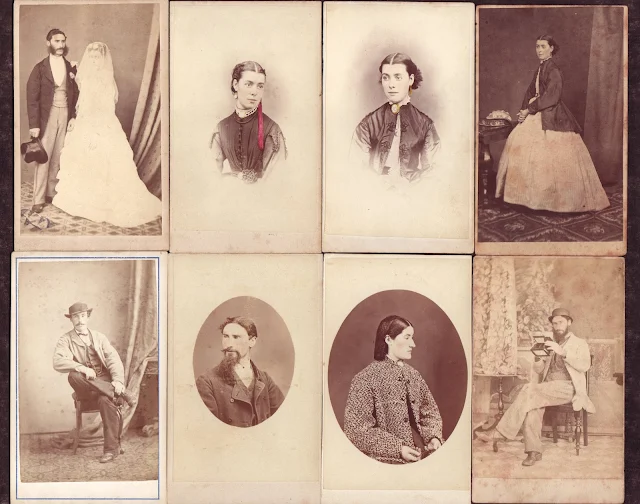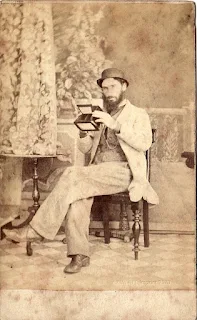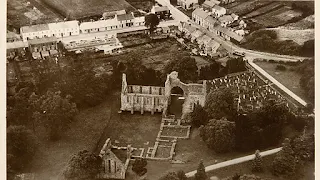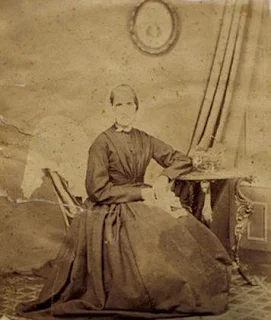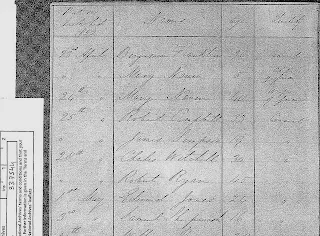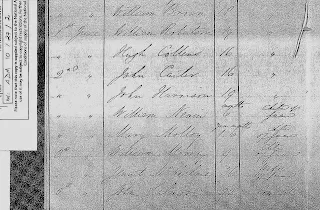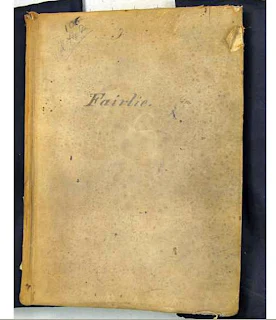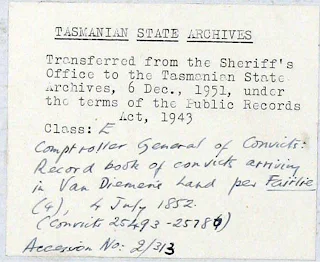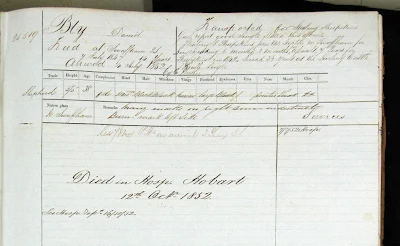"Nemo me impune Lacessit". "No-one touches me with impunity" (or "Dinna mess wi' me!")While research into the life and times of photographer Thomas J. Nevin (1842-1923) in Tasmania has uncovered many fascinating aspects of Australian colonial history, the life and times of his father John Nevin (1808-1887) opens up many more vistas on key world events.
John Nevin, father of Tasmanian photographer Thomas J. Nevin, was born in 1808 at Grey Abbey, County Down, a small town east of Belfast on the coast of Ireland. At that period the region was the centre of Irish cotton manufacturing and a growing centre of linen exports to rival Dublin. When John Nevin enlisted as a Private in the First or Royal Regiment of Foot in October 1825 (The Royal Scots) at the tender age of seventeen, his trade was "weaver". His service record shows he was under age at attestation. First service began at the age of 18 years.
John Nevin's full service lasted 14 years and 237 days in the West Indies and Canada. His record shows his service in the West Indies dated from 30th November 1827 to 30th January 1836, and in Canada from 16th June 1836. He was discharged at London, West Canada on 31 May 1841 on medical grounds (rheumatism, liver complaints, disease of the urinary organs), and returned to England eventually as a Chelsea pensioner.


SERVICE RECORD of John NEVIN
for the years 1825-1841 (12 images)
served in First, or Royal Regiment of Foot.
Source: Find My Past for UK Archives
Before leaving England once more to travel as a guard on board the convict ship the Fairlie in 1852, bound for Tasmania, Australia, John Nevin had become a husband and father of four children, and had spent a lonely and unprofitable time on the Californian gold fields, described in his poem "My Cottage in the Wilderness"(1868).
Here are details of his service with the Royal Scots 1st Regiment in Canada. See related posts below for his poetry written about Tasmania.

Back view of the church of St. Eustache and dispersion of the insurgents
Lord Charles Beauclerk (1813-1842)
1840, 19th century
Ink and watercolour on paper - Lithography
26.5 x 36.6 cm
Gift of David Ross McCord
M4777.6 © McCord Museum
Estampe. Vue arrière de l'église Saint-Eustache et dispersion des insurgés.
Encre et aquarelle sur papier - Lithographie (26.5 x 36.6 cm).
Bataille de Saint-Eustache, 14 décembre 1837 lors de la rébellion des Patriotes à Saint-Eustache, ville du Québec qui se situe au confluent de la rivière du Chêne et de la rivière des Mille-Îles, dans la MRC de Deux-Montagnes et les Basses-Laurentides à 30 km à l'ouest de Montréal au Canada.
Date 1840
JOHN NEVIN (1808-1887)
John Nevin's obituary, published in The Mercury , 11th October 1887, was written with deep affection and great respect. These details from the obituary of John Nevin's life add to what we already know of his exploits in the Californian gold fields, his arrival in Tasmania with his wife and four children as warden and guard on board the convict ship The Fairlie (1852), his life as a Wesleyan at Kangaroo Valley (Hobart) and his gift for writing poetry. From his obituary we learn that he pioneered journalism in London, Canada West, that he served proudly in the Royal Scots, and that he participated in the key battles of the Canadian Rebellion of 1837-1838 with Colonel G. A Wetherall and Lt D. Lysons ensign. He was in the Royal Scots, 2nd Battalion, 1st or Royal Regiment of Foot which proceeded to London (Ontario) in 1840 where he contributed to the Press:
Reminiscence, signed 'Old Royal':
"In 1840, the 2nd Battalion, 1st or Royal Regiment of Foot, left Montreal, for London, (Ontario), going by canal - sometimes towed by small puffers (steamers),which had to leave the boats on passing cateracts. On these occasions we went ashore and pulled the boats past the cateracts with ropes.. In this way we got as far as Hamilton, whence we had six day's march to London. We had no beds at night, we just picked out the softest place handy and our knapsacks did for pillows. Rations consisted of 1lb biscuit and 3/4lb salt pork, with sixpence a day pay - such were the rations and marching pay in those days in Canada."From General Sir Daniel Lysons, G C B (then Lieut. D. Lysons), writing in his 'Early Reminiscences', 1897, courtesy of https://www.theroyalscots.co.uk//page/shipwreck.
Cpt Wetherall 1818, Brown University Archives
What remains to be discovered is the date he left Canada, and when he returned to England. He was discharged from service in the Royal Scots at the Chelsea Royal Hospital for Veterans in 1841. His marriage took place to his first wife and mother of Thomas James, Rebecca Jane, Mary Ann and William John at sometime between 1838 and 1841. His service before embarking on the trip to Tasmania in 1852 which would change the history of his family forever, is unclear, although he wrote in his poem "My Cottage in the Wilderness" published in 1868, that he spent a miserable time on the Californian gold fields.
Why Tasmania? By more than just coincidence, George Arthur, the former Lieutenant Governor of Van Diemen's Land, 1823-1837 (as Tasmania was then known) was fresh from his recall from the penal colony when he was appointed Lieutenant Governor of Upper Canada. He took office in Toronto 23 March 1838 (until late 1841).

Major-General Sir George Arthur, Bart., KCB
[Lieutenant Governor of Upper Canada, 1838-41]
Archives of Ontario item reference code 69313
From the very start of his administration, Athur had to deal with the aftermath of the Upper Canada Rebellion. In 1828 Arthur had described his system as 'a natural and unceasing process of classification', i.e. a Benthamite surveillance system . In reality, Arthur's autocratic rule in Tasmania (Van Diemen's Land until 1856) resulted in failure to reform the colony and the system of penal transportation, leading to his recall in 1837. The capture of 92 Patriotes in 1838 under George Arthur's governorship resulted in their transportation to Van Diemen's Land:
After the failure of three separate raids between June and December, the defeated Patriots who survived were rounded up and tried, most of them for armed incursion under the legally dubious Lawless Aggressions Act. Ninety-two were transported to Van Diemen's Land by the Governor of Ontario, who was none other than George Arthur, former governor of the penal island. Ninety per cent were US citizens, while the rest were recent immigrants from Ireland and Scotland or from the Canadian colonies. Fourteen of the prisoners died while in exile, nearly 70 per cent returned to the USA and at least ten decided to stay in Australia. None took part in any further political activity.
Source: Raelene Frances, Review of American Citizens, British Slaves: Yankee Political Prisoners in an Australian Penal Colony 1839-1850, by Cassandra Pybus and Hamish Maxwell-Stewart, Melbourne University Press, Melbourne, 2002
Read this extended article by John C. Carter :
Uncertain Future in an Unknown Place:
North American Political Prisoners in Van Diemen's Land
Tasmanian Historical Research Association April 2010
John Nevin would have become well acquainted as a journalist with Arthur's stories of reform of the convict assignment in Tasmania, if not with Arthur himself while in London Ontario, and aware that captured Patriotes were being transported to Tasmania (VDL); indeed he was one of the Royals who assisted in their capture during the winter campaign of 1838.
OBITUARY: John Nevin (1808-1887)
DEATH OF AN OLD VETERAN.- There passed away very quietly on Sunday, 9th inst., at the good old age of 79, Mr. John Nevin, who for the last 30 years has lived in the secluded shades of Kangaroo Valley, adjoining Lady Franklin's old Museum. He lived a retired life on his pension and in working his plot of garden ground at the Wesleyan Chapel, enjoying the respect of all in the neighbourhood as a consistent Christian. His latter days were spent in quietness among his family, and he leaves a widow (a second wife) and two sons and several grandchildren in Hobart. Only a fortnight ago two friends of his, who were boys in the Royals, and had known him in Canada 50 years ago, paid him a visit, and a pleasant time was spent with him in recounting feats of valour long since almost forgotten. He was then enjoying good health, but last Wednesday, while working in his garden, he felt tired, and rested awhile on the damp ground, which caused a chill. He took to his bed, and, after three days' sickness, quietly joined the majority. In his day he was a wielder of the pen as well as of the sword, and was some 50 years ago a contributor to the infant Press in London, Canada West, when the present city of that name was a struggling town of rough and rude buildings and log huts. As a soldier of the Royal Scots he served under his colonel, Sir G.A. Wetherall, and the present Sir Daniel Lyons [i.e. Lysons] was his ensign; and he did his duty in very stirring times in the Canadian Rebellion of 1837-1838. He was engaged in the storming and capture of St.Charles and St. Eustache and in engagements of St. Dennis, St. Benoit, and many other operations on the Richelieu River and adjacent country of Chambly, and at Terra-Bone [i.e. Terrebonne] he assisted in the capture of a large number of French prisoners during a severe winter campaign, often struggling with his comrades to the waist in snow in following his officers in the work of quelling the rebellion of Papineau. John Nevin's proudest boast was that he had been a soldier of the Royals. (The Mercury, 11 October 1887).
The contributors to this obituary, most likely the old "boys in the Royals" who visited John Nevin in the weeks befor his death, may have held in hand the lithographs depicting each of the battles by Lord Charles Beauclerk (below) as they penned their tribute.

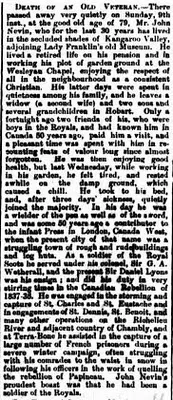
Photo of John Nevin taken by his son Thomas Nevin ca. 1873
From © KLW NFC Imprint 2005-2010 ARR.
Click on obit for readable version

Fort Chambly
Estampe, William Henry Bartlett, vers 1840.
Musée de la civilisation, dépôt du Séminaire de Québec
1993.16203.
HISTORICAL NOTES
Source: The Aftermath of the Rebellions
Brian J. Young, McGill University
View Flash video
"The Rebellions of 1837-1838 were the most dramatic political event in Canadian history. Issues such the control of Canada's future and the rights of French Canadians and working people in Upper Canadian shops and in the countryside sparked debates that ended in violence. Men talked of republicanism and independence before taking up arms and shooting at soldiers and their neighbours. The rebellions were forcibly put down, their leaders were hanged or exiled, and the country was placed under martial law. The rebellions shook not only Upper and Lower Canada, but disturbed British authorities in the mother country who began to worry about revolution in their most important colony.
One obvious response to rebellion, particularly to that of French Canadians in the Montreal area, was oppression and military control. In the short term, the British army and local English-speaking militias built up their defences, while the British flag and military uniform became even more visible in Montreal and in urban barracks throughout the colonies. Sent out to evaluate the Canadian situation, Lord Durham, who concentrated on Lower Canada, described French Canadians as 'stagnant' and 'illiterate,' 'a people with no history.'
But by the mid 1840s, there was a new writing on the wall: Britain made it clear that it would not opt for oppression or denial of parliamentary rights as a long-term solution for Canada. Tired of expenses for colonial soldiers and administrations, and anxious to collaborate with Canada's independent, republican neighbour, the United States, Britain abandoned its trade policy of mercantilism and its heavy involvement in Canadian political and economic life. English-Canadian leaders in Lower Canada had to accept British parliamentary practises, such as responsible government, assume the costs of their own colony, and envisage collaboration with French-Canadian leaders in a changing political system.
The transition was not easy. Federalism, that is, a division of powers between provinces and the central government, was one answer to the political crisis of the post-rebellion period and a solution that would surface as a central feature of the Canadian Confederation."
THE LITHOGRAPHS
Source: Musee McCord Museum
McCord Museum of Canadian History
690 Sherbrooke Street West
Montreal, Quebec H3A 1E9
These prints were part of a series showing British military life during the crisis of 1837. Back home in Britain they would be treasured as important records of military life in the colony.
The date of these prints is not always certain, as artists sometimes neglected to sign and date their work. Although dated around 1840, they depict events that took place in 1837. The series of prints done by Lord Charles Beauclerk, pays tribute to enlisted British men and their commanding officer, Sir George Augustus Wetherall.

Front view of the church of St. Eustache occupied by the insurgents.
Lord Charles Beauclerk (1813-1842)
1840, 19th century
M4777.5 © McCord Museum
As resistance moved north of Montreal, British forces were again able to organize their superior firepower against the patriotes, who came from the farming and professional community. Holed up in the church of St. Eustache and its convent and presbytery, patriote forces were shelled by British cannon beginning on December 14, 1837.

Attack on St. Charles
Lord Charles Beauclerk (1813-1842)
1840, 19th century
M972.81.10 © McCord Museum
Although 800 patriotes had beaten back British troops at St. Denis, British forces, as is evident from this print, had the advantage in terms of firepower. On November 25 at St. Charles, British forces defeated the patriotes, forcing many of their leaders into exile in the United States.

Col. Wetherall's bivouack at St. Hilaire de Rouville, 1840
Lord Charles Beauclerk (1813-1842)
1840, 19th century
M4777.2 © McCord Museum
Sir George Augustus Wetherall was a professional soldier in the British army. Born in England, he served in India before coming to Montreal to command the garrison. By 1835, civil unrest was taking hold in Lower Canada. The rebellions, concentrated in the Montreal region, broke out in the fall of 1837. As violence spread beyond Montreal, Wetherall led one part of the British pincer movement which was to attack the patriote stronghold of St. Charles. Wetherall's troops were camped at Mount St. Hilaire on November 23, 1837 when word came of the patriote victory at St. Denis.

Passage of the Richelieu by night, 22nd Nov. 1837
Lord Charles Beauclerk (1813-1842)
1840, 19th century
M4777.1 © McCord Museum
British refusal of the patriotes' program of 92 Resolutions (1834), along with an agricultural crisis and increasing hostility between French and English Canadians in Lower Canada, culminated in rebellion in the fall of 1837. Anglophones held mass meetings and armed themselves while the patriotes also formed a military group, the Fils de la Liberté. With warrants for their arrests issued in the autumn of 1837, the patriotes were forced to leave Montreal, pursued onto the south shore of the St. Lawrence River by well-armed British forces. The patriotes won the first battle at St. Denis on November 23 of that year.

A fortified pass. Colonel Wetherall advancing to the capture of St. Charles
Lord Charles Beauclerk (1813-1842)
1840, 19th century
Ink and watercolour on paper - Lithography
26.5 x 36.6 cm
Gift of Mr. David Ross McCord
M4777.3 © McCord Museum

Photograph
Louis-Joseph Papineau, Montreal, QC, 1861
William Notman (1826-1891)
1935-1956, 20th century
I-849.0.3 © McCord Museum
NOTES:
A patriote, Louis-Joseph Papineau was torn between the love of his seigneury, Montebello, and the active life of politics. As leader of the patriotes, Papineau would ensure that his name became synonymous with the nationalist movement in Lower Canada.
RELATED POSTS main weblog
- On board the Fairlie 1852 with the Parkhurst boys
- Nevins on sick list during voyage out on Fairlie 1852
- The Medical Officer's report of the Fairlie passengers 1852
- Mary and John Nevin, Thomas Nevin’s parents
- Kangaroo Valley and the New Town stereos
- John Nevin and Gould's white goshawk
- John Nevin: "My Cottage in the Wilderness" 1868
- Nevin farm burglariously entered 1881
- John Nevin’s Wesleyan Lament for William Genge





